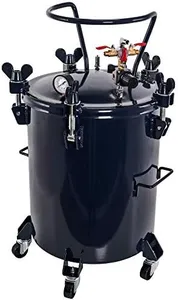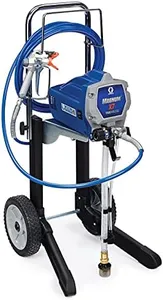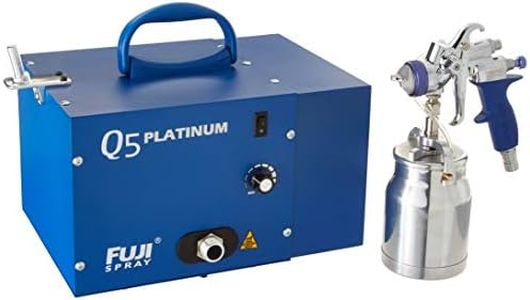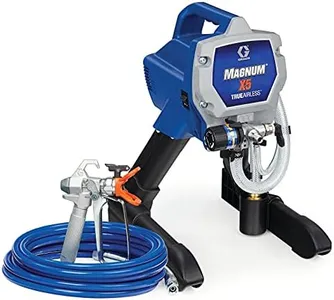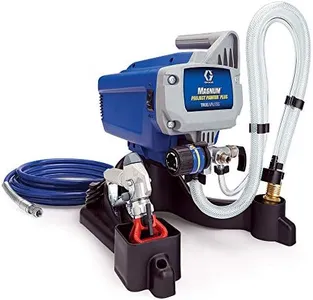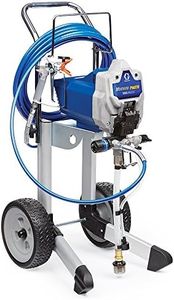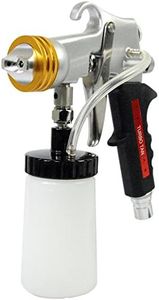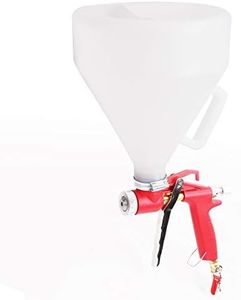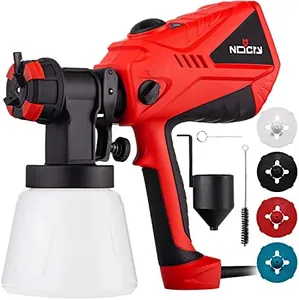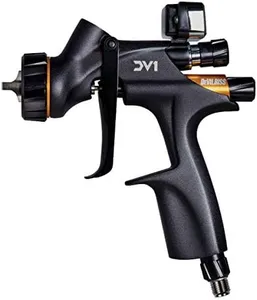10 Best Professional Paint Sprayers 2026 in the United States
Our technology thoroughly searches through the online shopping world, reviewing hundreds of sites. We then process and analyze this information, updating in real-time to bring you the latest top-rated products. This way, you always get the best and most current options available.

Our Top Picks
Winner
Graco Magnum 262805 X7 Cart Airless Paint Sprayer, Gray
Most important from
4131 reviews
The Graco Magnum 262805 X7 Cart Airless Paint Sprayer is a robust solution for professional painters or serious DIY enthusiasts. This airless sprayer can handle unthinned paint thanks to its stainless steel piston pump, making it versatile for a variety of projects. The adjustable pressure control allows you to customize the paint flow to suit any job – whether big or small. The RAC IV SwitchTip is handy for reversing clogs, ensuring continuous spraying without interruptions, which is a significant benefit for larger tasks.
With a flexible suction tube, this sprayer lets you draw directly from 1 or 5-gallon paint buckets, adding to its convenience and reducing the need for constant refills, beneficial for extensive projects. The ability to support up to 100 feet of hose makes it ideal for multi-story buildings, offering great reach and flexibility. Portability is addressed with a convenient cart design, which makes it easy to move around job sites, though its stainless steel build does add some weight. Cleaning is straightforward with the PowerFlush Adapter that connects to a garden hose, speeding up the cleaning process.
The sprayer's power source is limited to 110 volts, which is standard but could be a limitation in areas with different voltage requirements. The product is recommended for annual use of up to 125 gallons, making it suitable for frequent use but might be a limitation for industrial-scale projects. Despite its weight, this sprayer is a solid choice for its reliability, range of features, and ease of use, especially in residential and small commercial applications.
Most important from
4131 reviews
Fuji Spray 3005-T70 Q5 Platinum - T70 Quiet HVLP Spray System
Most important from
278 reviews
The Fuji Spray 3005-T70 Q5 Platinum HVLP Spray System is a high-performance paint sprayer that excels in several key areas for professional use. The 5-stage turbine is powerful, producing up to 9.5 psi, and the variable speed control dial allows users to adjust the motor speed to suit different spraying tasks. This is particularly advantageous for projects requiring precision and versatility. The quiet turbine and patented noise reduction feature make it suitable for use in noise-sensitive environments, and the Heat Dissipation Chamber (HDC) helps in prolonging the motor's lifespan by preventing overheating.
The professional spray gun is ergonomically designed with a side pattern control knob, enabling users to adjust the fan pattern size easily, contributing to a smoother application and finish. The 25ft hose is long enough to allow flexibility and mobility during projects, and it includes an air control valve to minimize overspray and bounce-back, ensuring a clean work area. The inclusion of the 5-for-5 Bonus Kit adds value, offering additional accessories for enhanced functionality.
However, the material is metal, which might make the sprayer heavier and potentially less portable than plastic alternatives. Additionally, while it offers excellent control and precision, the ease of cleaning might be a concern due to the complexity of the system's components. Nonetheless, this paint sprayer is well-suited for both professional painters and serious hobbyists looking for a reliable and versatile tool for detailed finishing work.
Most important from
278 reviews
Graco Magnum 262800 X5 Stand Airless Paint Sprayer, Blue
Most important from
6743 reviews
The Graco Magnum 262800 X5 Stand Airless Paint Sprayer is a strong contender for DIY homeowners and remodelers who need a powerful and mobile tool for larger projects. One of its standout features is the fully adjustable pressure control, which allows you to spray paints or stains unthinned at any pressure, giving you precise control over your work. The sprayer also supports up to 75 feet of paint hose, making it suitable for reaching high areas like second stories without losing performance.
The flexible suction tube is another handy feature, enabling you to spray directly from either 1 or 5-gallon paint buckets, adding to its convenience and efficiency for sizable tasks up to 10 gallons in size. With a maximum pressure of 3000 PSI and an electric power source, it provides sufficient power for most home improvement needs. Additionally, its stainless steel construction ensures durability and longevity.
Weighing 17 pounds, it strikes a balance between being robust and fairly portable. However, the weight might still be a bit cumbersome for some users if frequent movement is required. Another potential drawback is the cleaning process, which, though not complex, requires some effort due to the unit's design. Additionally, while the hose length is ample, the unit's size and dimensions might make storage a bit challenging if you have limited space. The Graco Magnum 262800 X5 is a reliable, high-performing paint sprayer suitable for various home projects, offering a good blend of power, versatility, and user-friendly features.
Most important from
6743 reviews
Buying Guide for the Best Professional Paint Sprayers
Choosing the right professional paint sprayer can make a significant difference in the quality and efficiency of your painting projects. Whether you're a contractor, a professional painter, or a serious DIY enthusiast, understanding the key specifications of paint sprayers will help you make an informed decision. The right sprayer will depend on the type of projects you undertake, the materials you use, and your personal preferences. Here are the key specifications to consider when selecting a professional paint sprayer.FAQ
Most Popular Categories Right Now
